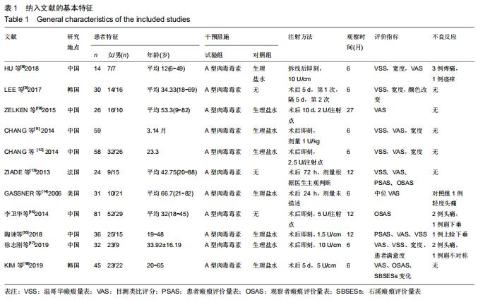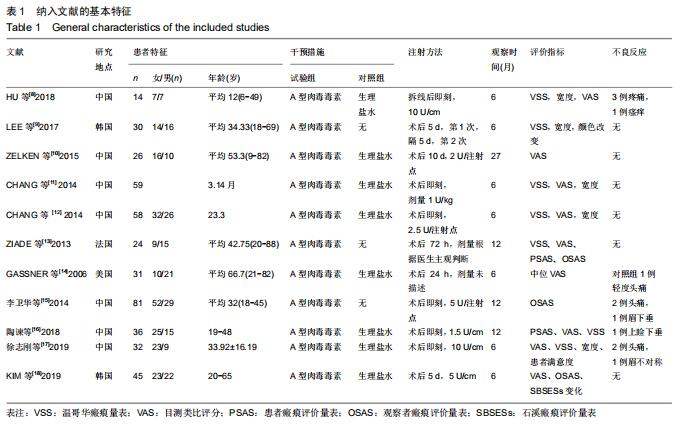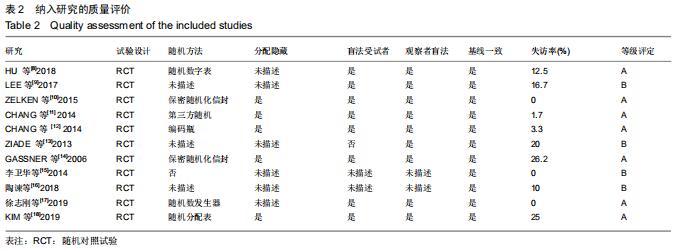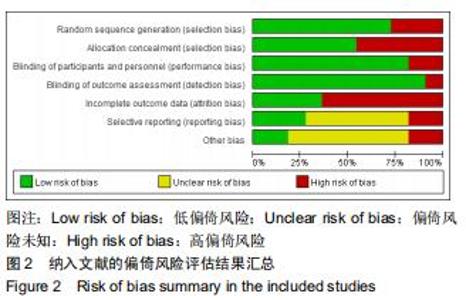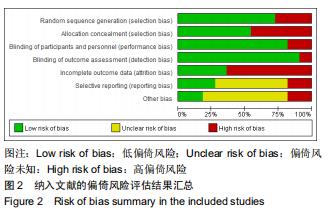Chinese Journal of Tissue Engineering Research ›› 2020, Vol. 24 ›› Issue (29): 4744-4750.doi: 10.3969/j.issn.2095-4344.2778
Previous Articles Next Articles
Botulinum toxin A injection in the prevention of facial trauma or postoperative hypertrophic scar: a systemic review of effectiveness and safety
Song Li, Ye Junru, Lu Mao, Tang Yi, Liu Yanlin, Chen Ximao
Department of Dermatology, First Affiliated Hospital of Chengdu Medical College, Chengdu 610500, Sichuan Province, China
-
Received:2019-11-12Revised:2019-11-16Accepted:2019-12-18Online:2020-10-18Published:2020-09-15 -
Contact:Song Li, Department of Dermatology, First Affiliated Hospital of Chengdu Medical College, Chengdu 610500, Sichuan Province, China -
About author:Song Li, Master, Associate chief physician, Department of Dermatology, First Affiliated Hospital of Chengdu Medical College, Chengdu 610500, Sichuan Province, China -
Supported by:a grant from Sichuan Provincial Health and Planning Commission, No. 20120148
CLC Number:
Cite this article
Song Li, Ye Junru, Lu Mao, Tang Yi, Liu Yanlin, Chen Ximao. Botulinum toxin A injection in the prevention of facial trauma or postoperative hypertrophic scar: a systemic review of effectiveness and safety[J]. Chinese Journal of Tissue Engineering Research, 2020, 24(29): 4744-4750.
share this article
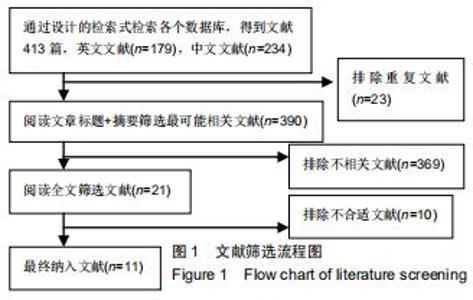
2.1 基本检索结果 按照设计的检索式在CCTR中检索出29篇,MEDLINE中122篇,Embase中28篇,中国期刊全文数据库和中文科技期刊全文数据库共234篇,共413篇。通过阅读题目和摘要,筛选出可能相关的共21篇[8-29]。找出全文并仔细阅读后,最终纳入11篇[8-18],其中英文8 篇[8-14,18],中文3篇[15-17],排除10篇[19-28]。排除的10篇中1篇为胸骨切开术后瘢痕[19],1篇为甲状腺切除术后瘢痕[20],1篇试验组为肉毒毒素+点阵激光+凝胶膜的综合治疗[21],5篇试验组都采用了肉毒毒素加用减张压迫法[22-26],1篇无对照[27],1篇是治疗已经形成的增生性瘢痕[28]。手工检索及附加检索无补充,见图1。 "
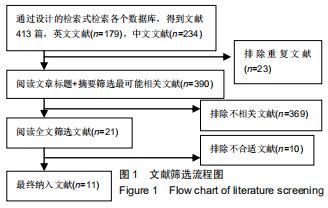

(2)目测类比评分(VAS):目测类比评分是主观评价量表,0分为无痛,10分为剧痛。共有9个临床试验采用了目测类比评分作为评价指标[8,10-14,16-18],1个临床试验显示肉毒毒素组中位评分8.9,而对照组7.2[14],差异有统计学意义,另一个临床试验显示目测类比评分肉毒毒素组评分提高2.92,而对照组为2.38[18],P=0.046,差异有统计学意义。7个临床试验纳入Meta分析[8,10-13,16-17],因其有统计学异质性,Tau2=2.96,Chi2=299.67,df=6(P < 0.000 01),I2=98%,于是采用了随机效应模式,结果2组差异有统计学意义(WMD=1.7,95%CI=0.38-3.02,P=0.01),试验组在目测类比评分方面优于对照组。见图4。 "

|
[1] BIJLARD E, KOUWENBERG CA,TIMMAN R, et al. Burden of keloid disease: a cross-sectional health-related qualit y of life assessment. Acta Derm Venereol.2017;97(2):225-229.
[2] OOSTERWIJK AM, MOUTON LJ, SCHOUTEN H, et al. Prevalence of scar contractures after burn: a systematic review.Burns.2017;43(1): 41-49.
[3] MARTINS JMP, OLIVEIRA FDS, LIMA EOC, et al. Use of derived adipose stem cells to reduce complications of c utaneous scarring in smokers. An experimental model in rats.Acta Cir Bras.2019;34(6): e201900605.
[4] MENEZES MCS, VASCONCELLOS LS, NUNES CB, et al. Evaluation of the use of tacrolimus ointment for the preve ntion of hypertrophic scars in experimental model.An Bras Dermatol.2019;94(2):164-171.
[5] 于水,王雅文,赵梓纲.A 型肉毒素在皮肤科的应用现状和前景[J].中国皮肤性病学杂志,2018,32(1):101-104.
[6] KASYANJU CARRERO LM, MA WW, LIU HF, et al. Botulinum toxin type A for the treatment and prevention of h ypertrophic scars and keloids: Updated review.J Cosmet Dermatol.2019;18(1):10-15.
[7] PRODROMIDOU A, FROUNTZAS M, VLACHOS DE, et al. Botulinum toxin for the prevention and healing of woun d scars: A systematic review of the literature.Plast Surg.2015;23(4): 260-264.
[8] HU L, ZOU Y, CHANG SJ, et al. Effects of botulinum toxin on improving facial surgical scars: a prospective, split-scar, double-blind, randomized controlled trial.Plast Reconstr Surg.2018;141(3):646-650.
[9] LEE SH, MIN HJ, KIM YW, et al. The efficacy and safety of early postoperative botulinum toxin A injectio n for facial scars.Aesthet Plast Surg.2018;42(2):530-537.
[10] ZELKEN J, YANG SY, CHANG CS, et al. Donor site aesthetic enhancement with preoperative botulinum toxin in f orehead flap nasal reconstruction.Ann Plast Surg.2016;77(5):535-538.
[11] CHANG CS, WALLACE CG, HSIAO YC, et al.Botulinum toxin to improve results in cleft lip repair. Plast Reco nstr Surg.2014;134(3):511-516.
[12] CHANG CS, WALLACE CG, HSIAO YC, et al. Botulinum toxin to improve results in cleft lip repair: a doubleblind ed, randomized, vehicle-controlled clinical trial.PLoS ONE.2014;9(12):e115690.
[13] ZIADE M, DOMERGUE S, BATIFOL D, et al. Use of botulinum toxin type A to improve treatment of facial woun ds: a prospective randomised study.J Plast Reconstr Aesthet Surg.2013;66(2):209-214.
[14] GASSNER HG, BRISSETT AE, OTLEY CC, et al. Botulinum toxin to improve facial wound healing: a prospective, blinded, placebo-controlled study.Mayo Clin Proc.2006;81(8):1023-1028.
[15] 李卫华,高玉伟,孙志成.A型肉毒毒素在面部直线形瘢痕修复术中的应用[J].中国美容整形外科杂志,2014,25(7):426-429.
[16] 陶谏,刘宾,汪阳,等.A 型肉毒毒素对减轻额部术后瘢痕增生的临床研究[J].陕西医学杂志,2018,47(8):1011-1013.
[17] 徐志刚,胡大海.A 型肉毒毒素减轻面部整形切口瘢痕的临床观察[J].安徽医药,2019,23(5):1010-1013.
[18] KIM SH, LEE SJ, LEE JW, et al. Clinical trial to evaluate the efficacy of botulinum toxin type A injection for reducing scars in patients with forehead laceration: A double-blinded, randomized controlled study. Medicine (Baltimore).2019;98(34):e16952.
[19] LI YH, YANG J, LIU JQ, et al. A Randomized, Placebo-Controlled, Double-Blind, Prospective Clinical Trial of B otulinum Toxin Type A in Prevention of Hypertrophic Scar Development in Median Sternotomy Wound.A esthetic Plast Surg.2018;42(5):1364-1369.
[20] KIM YS, LEE HJ, CHO SH, et al. Early postoperative treatment of thyroidectomy scars using botulinum toxin: a split-scar, double-blind randomized controlled trial.Wound Repair Regen.2014;22(5):605-612.
[21] 王小玉,王小琴,刘琰,等.面部小面积瘢痕手术切口早期应用A型肉毒毒素注射联合强脉冲光照射的临床效果[J].实用皮肤病学杂志,2013,6(5): 271-273.
[22] 杨萍,张子玉.A型肉毒毒素联合减张压迫法于面部整形切口愈合应用中的临床分析[J].中外女性健康研究,2017,18:59-64.
[23] 汪阳,张颖,田婧.局部注射 A 型肉毒毒素对额颞部良性肿瘤切除术后切口瘢痕增生的防治作用[J].河北医学, 2017,23(3):486-489.
[24] 杨瑞年,李明,吴承道.面部整形美容切口中A型肉毒毒素联合减张压迫法应用研究[J].中国医疗美容,2014,(6);3.
[25] 卫东.Botox A 早期切口内注射联合减张法对面部小面积瘢痕手术切口恢复效果的影响[J].医学研究杂志,2017,46(6):133-136.
[26] 刘涛,杨德发.A 型肉毒毒素+减张压迫法用于面部整形美容切口中的研究[J].中国医疗美容,2017,7(5):7-9.
[27] WILSON AM. Use of botulinum toxin type A to prevent widening of facial scars.Plast Reconstr Surg.2006;117(6):1758-1766.
[28] XIAO Z, ZHANG F, CUI Z. Treatment of hypertrophic scars with intralesional botulinum toxin type A injections: a preliminary report. Aesthetic Plast Surg.2009;33(3):409-412.
[29] GASSNER HG, SHERRIS DA, OTLEY CC. Treatment of facial wounds with botulinum toxin A improves cosmetic o utcome in primates.Plast Reconstr Surg.2000;105(6):1948-1953; discussion 1954-5.
[30] SHERRIS DA, GASSNER HG. Botulinum toxin to minimize facial scarring.Facial Plast Surg.2002;18(1):35-39.
[31] PRODROMIDOU A, FROUNTZAS M, VLACHOS DE, et al. Botulinum toxin for the prevention and healing of wound sca rs: A systematic review of the literature.Plast Surg.2015;23(4):260-264.
[32] ZHANG DZ, LIU XY, XIAO WL, et al. Botulinum Toxin Type A and the Prevention of Hypertrophic Scars on t he Maxillofacial Area and Neck: A Meta-Analysis of Randomized Controlled Trials. PLoS One.2016; 11(3): e0151627.
[33] WANG Y, WANG J, ZHANG J, et al. Effectiveness and Safety of Botulinum Toxin Type A Injection for Scar Preve ntion: A Systematic Review and Meta-analysis.AestheticPlast Surg.2019;43(5):1241-1249.
[34] 常宁,李广帅,刘林嶓,等.术后行肉毒毒素注射对切口愈合效果影响的Meta分析[J].中国美容医学,2015;24 (23):17-20.
[35] GILLANDERS SL, ANDERSON S, MELLON L, et al. A systematic review and Meta-analysis: Do absorbable or non-abso rbable suture materials differ in cosmetic outcomes in patients requiring primary closure of facial wounds? J Plast Reconstr Aesthet Surg.2018;71(12): 1682-1692. [36] COHEN JL, SCUDERI N. Safety and Patient Satisfaction of AbobotulinumtoxinA for Aesthetic Use: A Systematic Review.Aesthet Surg J.2017;37(suppl_1):S32-S44. |
| [1] | Hu Kai, Qiao Xiaohong, Zhang Yonghong, Wang Dong, Qin Sihe. Treatment of displaced intra-articular calcaneal fractures with cannulated screws and plates: a meta-analysis of 15 randomized controlled trials [J]. Chinese Journal of Tissue Engineering Research, 2021, 25(9): 1465-1470. |
| [2] | Huang Dengcheng, Wang Zhike, Cao Xuewei. Comparison of the short-term efficacy of extracorporeal shock wave therapy for middle-aged and elderly knee osteoarthritis: a meta-analysis [J]. Chinese Journal of Tissue Engineering Research, 2021, 25(9): 1471-1476. |
| [3] | Chen Junming, Yue Chen, He Peilin, Zhang Juntao, Sun Moyuan, Liu Youwen. Hip arthroplasty versus proximal femoral nail antirotation for intertrochanteric fractures in older adults: a meta-analysis [J]. Chinese Journal of Tissue Engineering Research, 2021, 25(9): 1452-1457. |
| [4] | Chen Jinping, Li Kui, Chen Qian, Guo Haoran, Zhang Yingbo, Wei Peng. Meta-analysis of the efficacy and safety of tranexamic acid in open spinal surgery [J]. Chinese Journal of Tissue Engineering Research, 2021, 25(9): 1458-1464. |
| [5] | Wang Yongsheng, Wu Yang, Li Yanchun. Effect of acute high-intensity exercise on appetite hormones in adults: a meta-analysis [J]. Chinese Journal of Tissue Engineering Research, 2021, 25(8): 1305-1312. |
| [6] | Kong Desheng, He Jingjing, Feng Baofeng, Guo Ruiyun, Asiamah Ernest Amponsah, Lü Fei, Zhang Shuhan, Zhang Xiaolin, Ma Jun, Cui Huixian. Efficacy of mesenchymal stem cells in the spinal cord injury of large animal models: a meta-analysis [J]. Chinese Journal of Tissue Engineering Research, 2021, 25(7): 1142-1148. |
| [7] | Huang Dengcheng, Wang Zhike, Cao Xuewei. Intravenous, topical tranexamic acid alone or their combination in total knee arthroplasty: a meta-analysis of randomized controlled trials [J]. Chinese Journal of Tissue Engineering Research, 2021, 25(6): 948-956. |
| [8] | Li Yan, Wang Pei, Deng Donghuan, Yan Wei, Li Lei, Jiang Hongjiang. Electroacupuncture for pain control after total knee arthroplasty: a meta-analysis [J]. Chinese Journal of Tissue Engineering Research, 2021, 25(6): 957-963. |
| [9] | He Xiangzhong, Chen Haiyun, Liu Jun, Lü Yang, Pan Jianke, Yang Wenbin, He Jingwen, Huang Junhan. Platelet-rich plasma combined with microfracture versus microfracture in the treatment of knee cartilage lesions: a meta-analysis [J]. Chinese Journal of Tissue Engineering Research, 2021, 25(6): 964-969. |
| [10] | Hua Haotian, Zhao Wenyu, Zhang Lei, Bai Wenbo, Wang Xinwei. Meta-analysis of clinical efficacy and safety of antibiotic artificial bone in the treatment of chronic osteomyelitis [J]. Chinese Journal of Tissue Engineering Research, 2021, 25(6): 970-976. |
| [11] | Zhan Fangbiao, Cheng Jun, Zou Xinsen, Long Jie, Xie Lizhong, Deng Qianrong. Intraoperative intravenous application of tranexamic acid reduces perioperative bleeding in multilevel posterior spinal surgery: a meta-analysis [J]. Chinese Journal of Tissue Engineering Research, 2021, 25(6): 977-984. |
| [12] | Zhong Yuanming, Wan Tong, Zhong Xifeng, Wu Zhuotan, He Bingkun, Wu Sixian. Meta-analysis of the efficacy and safety of percutaneous curved vertebroplasty and unilateral pedicle approach percutaneous vertebroplasty in the treatment of osteoporotic vertebral compression fracture [J]. Chinese Journal of Tissue Engineering Research, 2021, 25(3): 456-462. |
| [13] | Li Yang, Zhang Mingyong. Meta-analysis of the effect of double Endobutton and clavicular hook plate on the treatment of acromioclavicular dislocation [J]. Chinese Journal of Tissue Engineering Research, 2021, 25(3): 463-470. |
| [14] | Li Yanle, Yue Xiaohua, Wang Pei, Nie Weizhi, Zhang Junwei, Tan Yonghai, Jiang Hongjiang. Intramedullary nail fixation versus plate fixation in the treatment of displaced midshaft clavicular fractures in adults: a meta-analysis [J]. Chinese Journal of Tissue Engineering Research, 2021, 25(3): 471-476. |
| [15] | Liu Chang, Han Shufeng. Interlocking intramedullary nail for proximal femur versus proximal femoral anti-rotation intramedullary nail or proximal femoral anti-rotation intramedullary nail of Asian for intertrochanteric fractures in older adults: a meta-analysis [J]. Chinese Journal of Tissue Engineering Research, 2021, 25(3): 477-485. |
| Viewed | ||||||
|
Full text |
|
|||||
|
Abstract |
|
|||||
